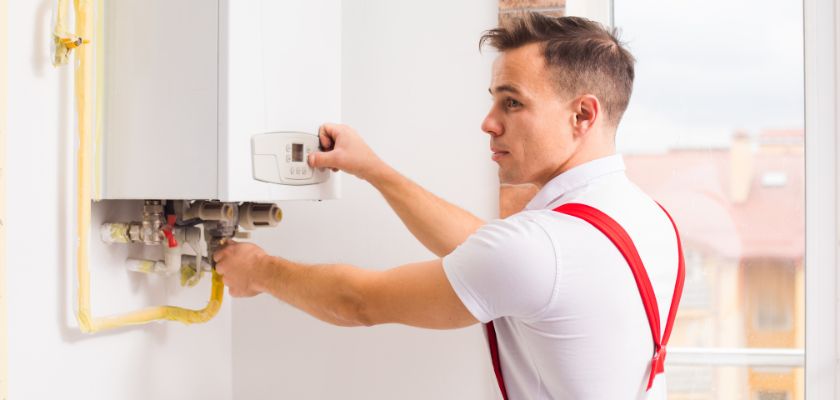Proper maintenance of your water heater is essential to ensure its longevity and efficiency. Regular upkeep can prevent common issues and help you avoid costly repairs or replacements. Whether you’re dealing with a recent water heater installation in North Richland Hills TX, or looking to improve the performance of your current unit, these maintenance tips will keep your water heater in top shape.
Table Of Contents
Regular Inspections and Flushing

Conducting Routine Inspections
One of the simplest ways to maintain your water heater is through regular inspections. Check for signs of leaks, rust, or corrosion around the tank and its connections. Early detection of these issues can prevent more significant problems down the line. Make sure to inspect both the interior and exterior of the unit at least twice a year.
Flushing the Tank
Sediment buildup in the tank can reduce the efficiency of your water heater and lead to premature wear. Flushing the tank at least once a year removes this buildup and improves the unit’s performance. Turn off the power supply, connect a garden hose to the drain valve, and flush out the water until it runs clear. This process helps maintain optimal water quality and efficiency.
Checking the Anode Rod
The anode rod is a critical component that prevents the tank from rusting. Over time, it corrodes and needs replacement. Check the anode rod annually and replace it if it is heavily corroded. This simple step can significantly extend the lifespan of your water heater by protecting the tank from corrosion.
Temperature and Pressure Relief Valve Maintenance
Testing the TPR Valve
The Temperature and Pressure Relief (TPR) valve is a safety feature that prevents the tank from overheating or overpressurizing. To test the TPR valve, lift the lever and allow it to snap back. You should hear a rush of water into the drainpipe. If the valve doesn’t release water, it may be faulty and needs replacement.
Adjusting the Temperature Setting
Maintaining the correct temperature setting on your water heater is crucial for safety and efficiency. The recommended setting is typically around 120 degrees Fahrenheit. This temperature is sufficient for household needs while minimizing the risk of scalding and reducing energy consumption. Lowering the temperature can also prevent overheating and prolong the unit’s lifespan.
Inspecting for Leaks
Regularly inspect the TPR valve and surrounding areas for any signs of leaks. Leaks can indicate a failing valve or excessive pressure within the tank. Addressing leaks promptly prevents water damage and ensures the continued safe operation of your water heater.
Insulating the Water Heater and Pipes
Insulating the Tank
Insulating your water heater can improve its efficiency by reducing heat loss. This is especially important for older models. Use a water heater insulation blanket, following the manufacturer’s guidelines to avoid covering important components like the thermostat or TPR valve. Proper insulation helps maintain the desired water temperature and reduces energy consumption.
Insulating Hot Water Pipes
Insulating hot water pipes minimizes heat loss as water travels from the heater to your faucets. This not only improves energy efficiency but also reduces the time it takes for hot water to reach your taps. Use pipe insulation sleeves or wraps to cover the hot water pipes, especially those running through unheated areas.
Preventing Pipe Freezing
In colder climates, frozen pipes can be a significant concern. Insulating pipes helps prevent freezing and potential bursts, which can cause extensive damage. Ensure all exposed pipes, especially those in unheated areas like basements or crawl spaces, are adequately insulated.
Final Wording
In conclusion, regular maintenance of your water heater is vital for extending its lifespan and ensuring efficient operation. By conducting routine inspections, flushing the tank, checking the anode rod, and maintaining the TPR valve, you can prevent common water heater installation mistakes and enhance the performance of your unit. Additionally, insulating the tank and pipes can improve energy efficiency and protect your system from damage. Whether you’re dealing with a new water heater installation in North Richland Hills TX, or maintaining an existing unit, these tips will help you get the most out of your water heater. Embrace these maintenance practices to enjoy reliable hot water and extend the life of your investment.
FAQ’s
Regular inspections help detect early signs of leaks, rust, or corrosion, preventing more significant problems and costly repairs. By catching issues early, you can maintain your water heater’s efficiency and extend its lifespan.
It is recommended to flush your water heater tank at least once a year. This helps remove sediment buildup, which can reduce efficiency and cause premature wear on the unit. Regular flushing ensures better performance and longevity.
The anode rod is a component that prevents the water heater tank from rusting by attracting corrosive elements. Checking it annually and replacing it when heavily corroded can significantly extend the life of your water heater by protecting the tank from corrosion.
To test the TPR valve, lift the lever and let it snap back. You should hear a rush of water into the drainpipe. If the valve doesn’t release water, it may be faulty and need replacement. Regular testing ensures the safety and proper functioning of your water heater.
Insulating your water heater and hot water pipes reduces heat loss, improving energy efficiency and reducing energy bills. It also helps maintain the desired water temperature and prevents pipes from freezing in colder climates, ensuring consistent hot water supply.







